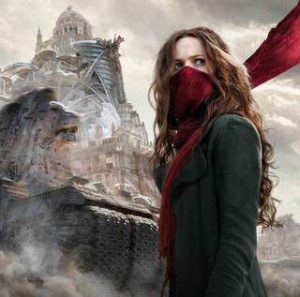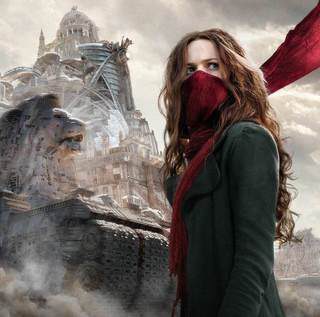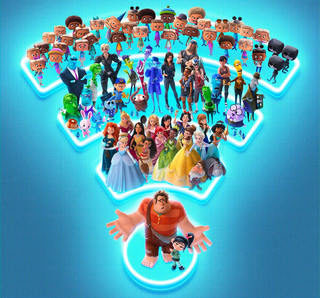“Chronicles of predatory cities”: the triumph of the picture over the meaning
 Authors, artists and other creators regularly come up with a variety of ends of the world for our world, describe in detail the worlds that grow out of the ashes of a nuclear war or some major cataclysm. Each Apocalypse is different details, but all scenarios are similar in one thing: people do not change and still crave power, strength and power, despite the mistakes of the past. In the film “Chronicles of predatory cities” (Mortal Engines) also shows this story.
Authors, artists and other creators regularly come up with a variety of ends of the world for our world, describe in detail the worlds that grow out of the ashes of a nuclear war or some major cataclysm. Each Apocalypse is different details, but all scenarios are similar in one thing: people do not change and still crave power, strength and power, despite the mistakes of the past. In the film “Chronicles of predatory cities” (Mortal Engines) also shows this story.
The basis for the film was a series of books by Philip Reeve-teenage adventure novels. And the first film almost completely illustrates the events described in the first book, slightly changing the details, removing most of the clumsy teardrop moments, but generously scattering epicness.The film catches its scale. At the heart of the story — the city, moving on caterpillar, wheeled or some other course on the pitted, killed post-apocalyptic wasteland. Cities behave like predators-the strong devour the weak, disassemble for parts, take the inhabitants into slavery: such a social system was even given the name “municipal Darwinism”.
You can guess why the city suddenly got on the wheels: the usual ways of obtaining resources disappeared with the end of the world and the survivors were looking for new ones, along the way fleeing from hurricanes, floods, earthquakes and other cataclysms of the war-scarred Earth. But the direct text of this idea in the film is not spoken — we are immediately greeted by a grandiose, carefully orchestrated scene of the chase of one city after another.
Visually the film is luxurious. All the giant, unrealistic machinery is depicted with special love and attention to detail. After the “60-minute war”, which brought the Apocalypse a thousand years before the events of the film, the world decided to go, rather, on the steampunk path, and because the huge cities of nadsadno puffing steam engines, and above them circling blimps bizarre shapes that do not agree with the laws of aerodynamics. The picture is simply impressive.But this should not be surprising: the film was the directorial debut of Christian rivers, since 1992, working together with Peter Jackson as an artist and a specialist in visual effects. In this picture, Jackson became a producer, working on the script, as in other films, together with Philippa Boyens and Fran Walsh, but it was rivers who directed. And the hand of the artist is felt throughout. Almost any frame from the “Chronicles” can be put as Wallpaper on your desktop.
And this, in principle, is the main and only advantage of the film. The excellent Visualizer, unfortunately, could not put interesting dialogues and teach characters to interact with each other in a non-cardboard way. Each character exists as if by itself, talking either to the wall, or to the tree. Each character is interesting in its own way, but they can not talk to others. And I can not say that this is the fault of the actors-in the lead roles here are quite experienced Hugo weaving and Robert Sheehan (the latter is familiar, for example, on a very lively British TV series “Scum”, in which quality dialogues are rife), and they know how to play.
Icelandic Hera Hilmar in the role of the main rebel looks organic, but, again, it is good in itself, in static, without interaction with the world or with other actors. It was this living connection between the characters that rivers lost — he could not fit people into the world he painted.
I honestly I’d say: the film goes 2.5 hours, book, on which he cesspits, can be read for 3.5, and the film in been more exciting. The book is written in the simple language of a fourteen-year-old schoolgirl, in which suddenly jump out the stubs of text with a rating of “mature” and empty, mechanical descriptions of dismemberment. The film is due to the juicy, full of details of the picture, quality effects, proper camerawork draws in so much that the simplicity of the plot and the absence of at least some emotions in the interaction of the actors does not even fade into the background, but into the third or fourth.
And this is understandable-the primary source itself is empty and good only idea, to pull out of it something at least a little meaningful is simply unrealistic. But the film was able to take this idea, squeeze out of it a concentrated essence and embody in CGI, pavilions and props, not even a hundred, but all three hundred percent.
People in this feast of visual effects are simply not needed. The script is only necessary in order to show another breathtaking location, the next large-scale battle, the next big technological vundervaflâ. In principle, the whole film could be viewed without sound, just admiring the pictures and losing nothing — but the soundtrack was handled by Junkie XL, and he did his job well. It is a pity that periodically his melodies are interrupted by empty dialogues, but what can you do. This is not a documentary about Baikal.
On the other hand, from teenage novels in a dystopian setting, in principle, do not expect deep ideas, elaborate plot and unconventional characters. “Chronicles of predatory cities” is the best visual attraction this year, I think. And more from him is not required.
Apparently, it will be the first film in the trilogy dedicated to the wasteland plowing machines, and if successful, once in a couple of years on New Year’s eve, we will be waiting for another large-scale battle, caressing the eye. I probably don’t mind after all.


